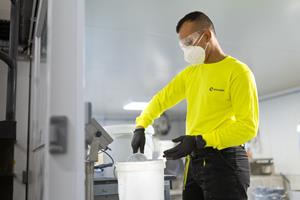Ecocem Achieves ASTM C1157 Certification, Signaling U.S. Market Readiness for Breakthrough Low-Carbon Cement
Performance-based certification confirms Ecocem meets U.S. durability and strength standards
HOUSTON, Aug. 12, 2025 (GLOBE NEWSWIRE) -- Ecocem, Europe’s leading provider of low-carbon cement technologies, today announced it has achieved ASTM C1157 certification for Ecocem’s revolutionary ACT I cement. This major milestone affirms the performance, durability and reliability of ACT, its scalable low-carbon cement technology, for use in the U.S. market. The accreditation confirms that Ecocem’s product meets or exceeds the industry benchmarks for strength and durability, while reducing carbon emissions and energy use.
Unlike traditional cement specifications that prescribe raw material composition, ASTM C1157 is a performance-based standard, allowing for innovative formulations. Surpassing these standards, Ecocem’s ACT technology proves that sustainable cement can also be high-performing and highly efficient in terms of material usage and cost-effective.
At a time when the U.S. imports nearly a quarter of its cement, Ecocem’s technology offers a domestic solution to strengthen local supply chains and support energy and industrial policy goals across the political spectrum. The company is actively developing strategic partnerships with U.S.-based concrete producers and infrastructure developers to demonstrate ACT’s performance at scale in American markets.
“This certification is more than a technical achievement. It is a signal to the U.S. market that we’re ready to deliver a scalable decarbonization technology,” said Steve Bryan, Managing Director, Ecocem Americas. “ASTM C1157 validates that our ACT technology performs to the highest standards, allowing it to integrate easily into existing supply chains and offer a powerful pathway for the U.S. to decarbonize the cement and concrete industrial sector through improved efficiency, without increasing costs or complexity.”
ACT, Ecocem’s scalable low-carbon cement technology, can reduce CO2 from cement manufacturing while delivering the necessary strength, durability and workability required in any concrete it is used to manufacture. ACT reduces cement emissions by cutting clinker content by up to 70% and replacing it with abundantly available materials, such as limestone, and locally sourced supplementary cementitious materials (SCMs). Clinker, the key reactive component in cement, is responsible for over 90% of its carbon emissions. By optimizing the interaction and performance of SCMs and engineered mineral admixtures, ACT not only lowers clinker content but also enables much more efficient use of SCMs, delivering high-performance, low-carbon cement at scale.
Further, ACT technology does not require significant modifications to existing cement and concrete production processes. It allows for the use of standard practices and equipment, making it feasible for most cement plants to easily adopt. This approach requires minimal additional capital expenditure or industrial transformation, as it uses the majority of existing assets along with local raw materials.
This announcement comes as Ecocem moves forward with its first North American project: a proposed Terminal and Milling Operation at the Port of Los Angeles. Still in the early stages of planning and review, the facility intends to establish a reliable, resilient supply chain for producing low-carbon, high-performance cement in California and support the state with the durable infrastructure required for long-term economic growth.
To learn more about how Ecocem can deliver low-carbon cement to your market or serve as a partner in North America, please visit www.ecocemglobal.com/en-us/contact/.
About Ecocem
Ecocem is a pioneer of high-performance technology that significantly reduces CO2 emissions in the cement and construction industries. Its breakthrough low-carbon cement technology, ACT, can reduce the global carbon footprint of the traditional cement manufacturing process by more than half.
For more than 20 years, Ecocem has been developing, manufacturing, and supplying low-carbon cement and construction solutions to markets in Europe. It operates from plants in France (2), the Netherlands, and Ireland, with an annual production of over two million tons of low-carbon cements.
From Le Grand Paris Express to Dublin’s Aviva Stadium, the Paris Olympic Athletes’ Village 2024, and the UK’s high-speed railway HS2, Ecocem has achieved a cumulative reduction of 18 million tons of CO2 emissions to date. It would take over 800 million trees to capture this amount of CO2 in a year. In the United States, Ecocem is embarking on one of its biggest projects to date, the construction of a Terminal and Milling Operations at the Port of Los Angeles. This is Ecocem’s first North American operation.
Investors in Ecocem include Saint-Gobain Group, a global leader in light sustainable construction, and Breakthrough Energy Ventures. Ecocem also counts ArcelorMittal, the world’s leading steel and mining company, as a major shareholder in its Ecocem France subsidiary.
In February 2025, Ecocem announced an investment of €50 million to build its first production facility dedicated to ACT at its Dunkirk site, increasing production capacity to over 1 million tons per year by 2026.
In May 2025, an additional €170 million was announced to construct four new production lines in France and accelerate the delivery of ACT. An independent company with a world-class innovation center, Ecocem technology, products, and services can help the cement industry cost-effectively decarbonize by 50% by 2030—and build a more sustainable future for all.
Contact
Liam Sullivan for Ecocem
A photo accompanying this announcement is available at https://www.globenewswire.com/NewsRoom/AttachmentNg/8628d967-3c86-438a-a802-a9f800471959

Legal Disclaimer:
EIN Presswire provides this news content "as is" without warranty of any kind. We do not accept any responsibility or liability for the accuracy, content, images, videos, licenses, completeness, legality, or reliability of the information contained in this article. If you have any complaints or copyright issues related to this article, kindly contact the author above.

